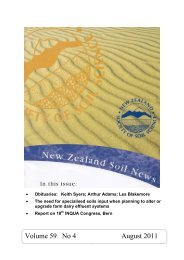Download - New Zealand Society of Soil Science
Download - New Zealand Society of Soil Science
Download - New Zealand Society of Soil Science
Create successful ePaper yourself
Turn your PDF publications into a flip-book with our unique Google optimized e-Paper software.
Editorial – by Iris Vogeler<br />
I have just returned from a trip to Europe, where I attended the Water Resources Management<br />
Conference that took place in the island <strong>of</strong> Malta. Water management is a topic <strong>of</strong> growing concern<br />
all over the world, and water has become a very precious resource.<br />
The Maltese Islands are densely populated and with an average annual rainfall <strong>of</strong> 578 mm one can<br />
easily understand that potable water has always been a challenge. There are no surface waters that can<br />
be exploited easily, and groundwater is under increasing competition. Historically Maltese people<br />
have coped with water scarcity through a limited allocation <strong>of</strong> water per person. Since the early<br />
1970‘s a large portion, now over 50%, <strong>of</strong> the urban water demand has been coming from de-salination<br />
plants. The population and tourists are now served with good quality drinking and the ―water culture‖<br />
takes only limited interest in efficient use <strong>of</strong> water resources. Between 200 and 2007 the largest<br />
consumption <strong>of</strong> water, with 25%, was by Hotels and Restaurants, and agriculture and related services<br />
only used 5%. Farmers are generally more conscious <strong>of</strong> the importance <strong>of</strong> water conservation, but<br />
increased irrigation demand has resulted in increased salinity <strong>of</strong> the aquifer systems as a result <strong>of</strong><br />
seawater intrusion. Currently the aquifers are extracted at twice the recommended amount, and<br />
climate change with predicted rainfall decreases in the Mediterranean <strong>of</strong> 30% will exacerbate the<br />
problem. Nitrate contamination due <strong>of</strong> intensive farming and dependence <strong>of</strong> oil imports for<br />
desalination are <strong>of</strong> rising concern. With these problems Malta was a perfect scene setting for the<br />
Water Resource Management Conference.<br />
One <strong>of</strong> the foci the conference, I would like to draw attention to, was the EU Water Framework<br />
Directive (WFD, 2000) and the Groundwater Directive (2006) with the objective to harmonise water<br />
environmental policy and regulation across Europe. Twelve "Water Information Notes" give an<br />
introduction and overview <strong>of</strong> key aspects <strong>of</strong> the implementation <strong>of</strong> the Water Framework Directive. If<br />
you are interested look at: http://ec.europa.eu/environment/water/participation/notes_en.htm.<br />
In NZ we are pretty lucky: less than 5 percent <strong>of</strong> <strong>New</strong> <strong>Zealand</strong>'s freshwater was allocated in 2006<br />
(irrigation accounted for 77% <strong>of</strong> the allocation) and we do not have any neighbouring countries to<br />
compete with. However, increasing demands and climate change predictions reinforce the need for<br />
careful water resource management in <strong>New</strong> <strong>Zealand</strong>. And let‘s see how water footprinting shapes up<br />
for us. Have a look at Brent Clothier‘s thoughts on this (NZ Herald, 15.9.2009). Leaving it with these<br />
thoughts I and wish you all the best for the remaining year.<br />
Valletta, Capital <strong>of</strong> Malta<br />
Iris Vogeler<br />
154










